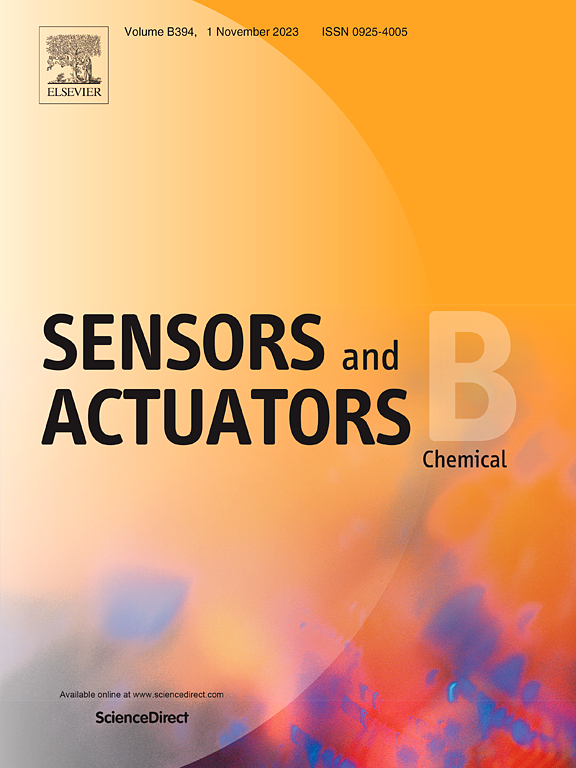An innovative hydrogel-based colorimetric freshness indicator array for smart packaging of bananas, apples, and pears
IF 8
1区 化学
Q1 CHEMISTRY, ANALYTICAL
引用次数: 0
Abstract
Real-time monitoring of volatile organic compounds (VOCs) released from perishable fruits is essential for predicting their freshness. Herein, we designed a non-destructive and portable hydrogel-based colorimetric freshness indicator array for on-site monitoring of acetone, acetaldehyde, and propionaldehyde markers in yellow fruits such as bananas, apples, and pears. These VOCs serve as critical indicators of fruit spoilage. The colorimetric sensor array is constructed from a calcium alginate pad (CAP) modified with a hydrogel blend of xanthan (XG) and tragacanth gum (TG), incorporating zinc oxide nanoparticles (ZnO-NPs) as a stabilizing filler. Additionally, the array utilizes glycerol as a crosslinker, along with bromocresol purple (BCP), methyl orange (MO), BCP/thymol blue (ThB), and bromocresol green (BCG) as color-sensitive materials. This array is integrated with smartphone technology and color analysis software, allowing for real-time detection of color changes. The results demonstrate a strong correlation between the concentrations of acetaldehyde, propionaldehyde and acetone, and the color intensity, with measurable ranges of 0.117–3.92 ppm, 0.153–5.202 ppm and 0.088–5.032 ppm and the respective limits of detection were determined to be 0.11, 0.14 and 0.07 ppm, respectively. Furthermore, the sensors exhibited no adverse effects on water vapor permeability or the VOC materials. They showed a desirable recovery, enabling effective monitoring of quality changes in fruits during storage at both room temperature and in refrigeration. This research provides valuable insights for the design and development of solid-state strip sensors and simple packaging indicators, facilitating the assessment of fruit freshness through smartphone-based online signaling and data analysis.

用于香蕉、苹果和梨智能包装的创新型水凝胶比色新鲜度指示器阵列
对易腐水果挥发性有机化合物(VOCs)的实时监测是预测其新鲜度的必要条件。在这种情况下,我们提出了一种非破坏性的便携式水凝胶比色新鲜度指示阵列,用于现场监测黄色水果(如香蕉、苹果和梨)中的丙酮、乙醛和丙醛标记物。这些挥发性有机化合物是水果变质的关键指标。该比色传感器阵列由黄原胶(XG)和黄原胶(TG)的水凝胶混合物修饰的海藻酸钙垫(CAP)构成,并加入氧化锌纳米颗粒(ZnO-NPs)作为稳定填料。此外,该阵列利用甘油作为交联剂,与溴甲酚紫(BCP)、甲基橙(MO)、BCP/百里酚蓝(ThB)和溴甲酚绿(BCG)作为色敏材料。该阵列集成了智能手机技术和颜色分析软件,可以实时检测颜色变化。结果表明,乙醛、丙醛和丙酮的浓度与颜色强度有较强的相关性,可测范围为0.117 ~ 3.92 ppm、0.153 ~ 5.202 ppm和0.088 ~ 5.032 ppm,检出限分别为0.11、0.14和0.07 ppm。此外,传感器对水蒸气渗透性和VOC材料没有不利影响。它们表现出了理想的恢复,能够有效地监测水果在室温和冷藏储存期间的质量变化。该研究为固态条形传感器和简单包装指示器的设计和开发提供了有价值的见解,通过基于智能手机的在线信令和数据分析促进了水果新鲜度的评估。
本文章由计算机程序翻译,如有差异,请以英文原文为准。
求助全文
约1分钟内获得全文
求助全文
来源期刊

Sensors and Actuators B: Chemical
工程技术-电化学
CiteScore
14.60
自引率
11.90%
发文量
1776
审稿时长
3.2 months
期刊介绍:
Sensors & Actuators, B: Chemical is an international journal focused on the research and development of chemical transducers. It covers chemical sensors and biosensors, chemical actuators, and analytical microsystems. The journal is interdisciplinary, aiming to publish original works showcasing substantial advancements beyond the current state of the art in these fields, with practical applicability to solving meaningful analytical problems. Review articles are accepted by invitation from an Editor of the journal.
 求助内容:
求助内容: 应助结果提醒方式:
应助结果提醒方式:


